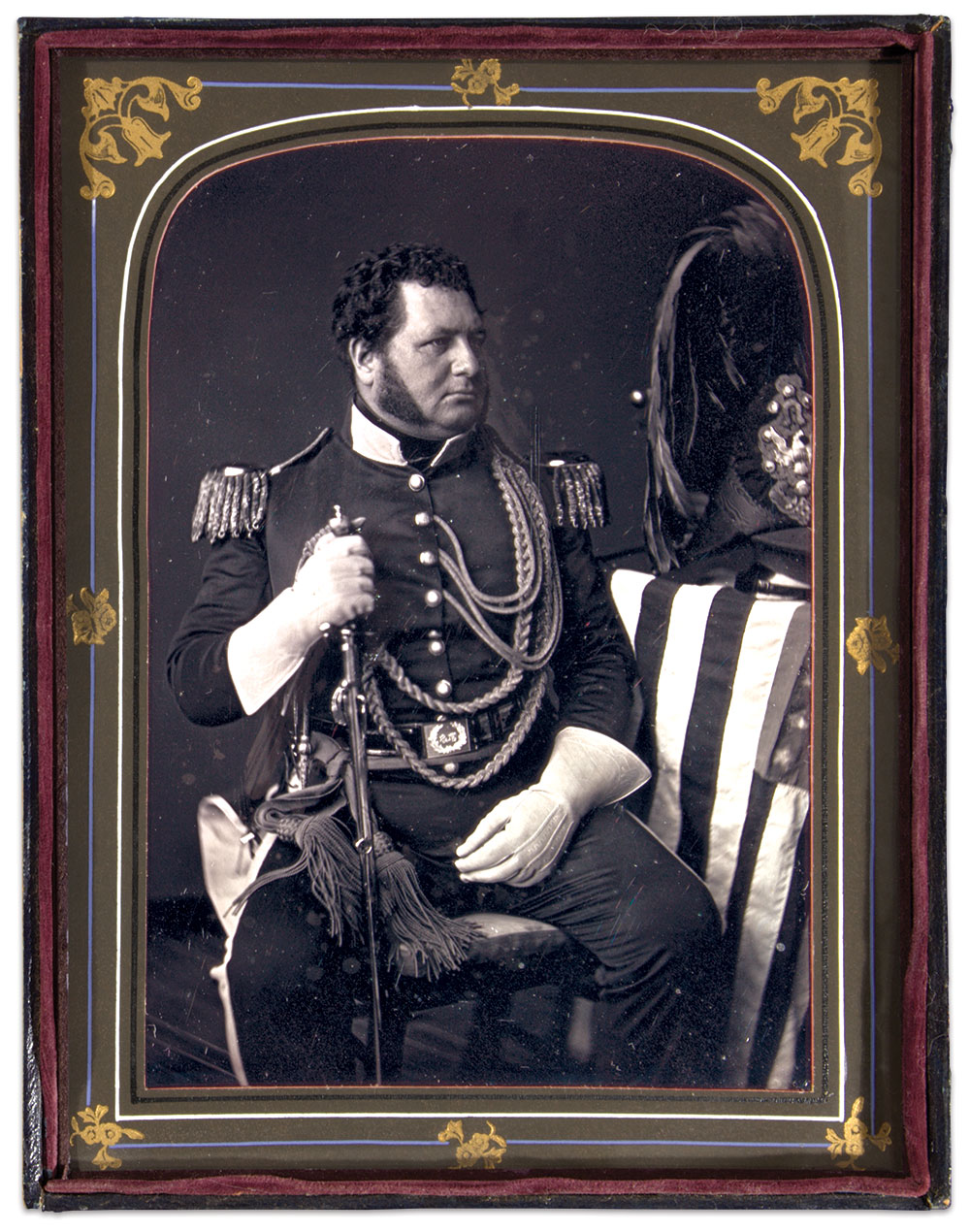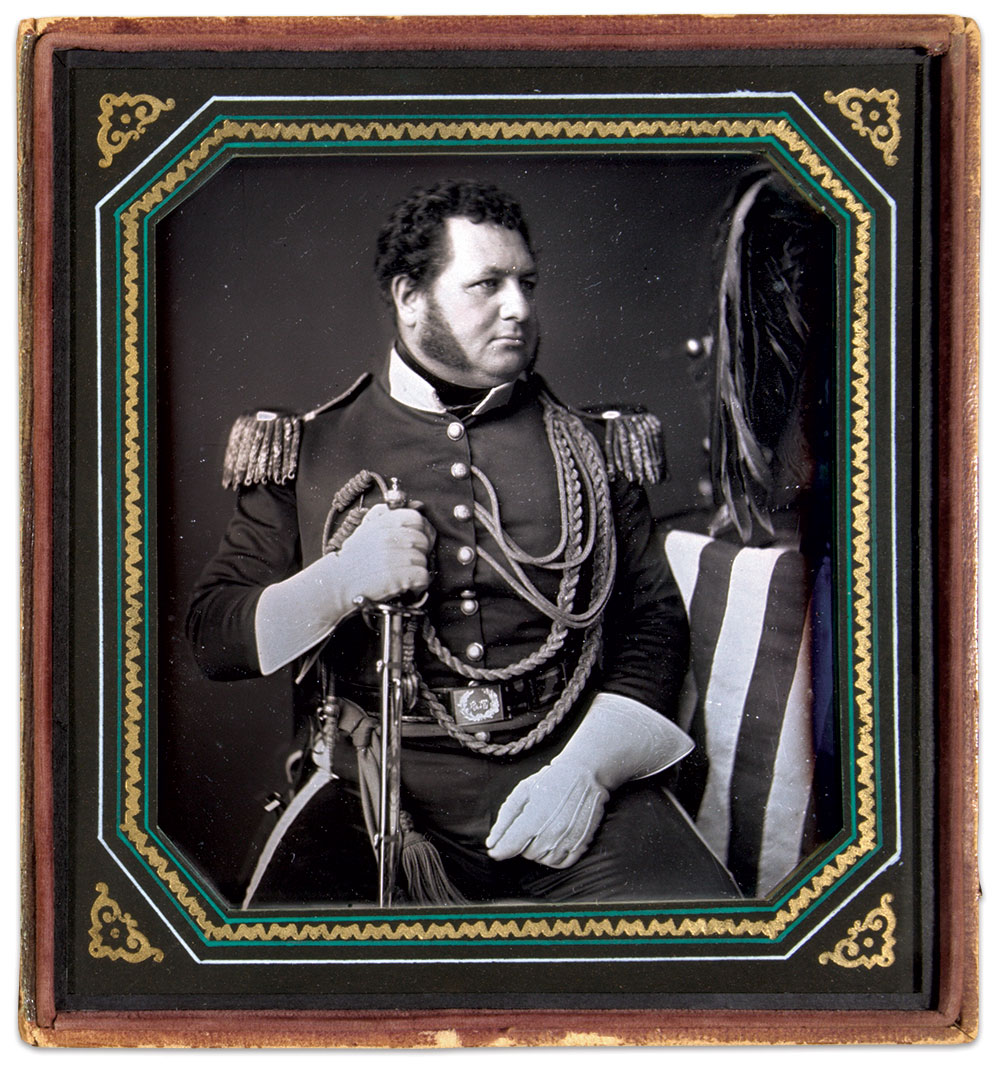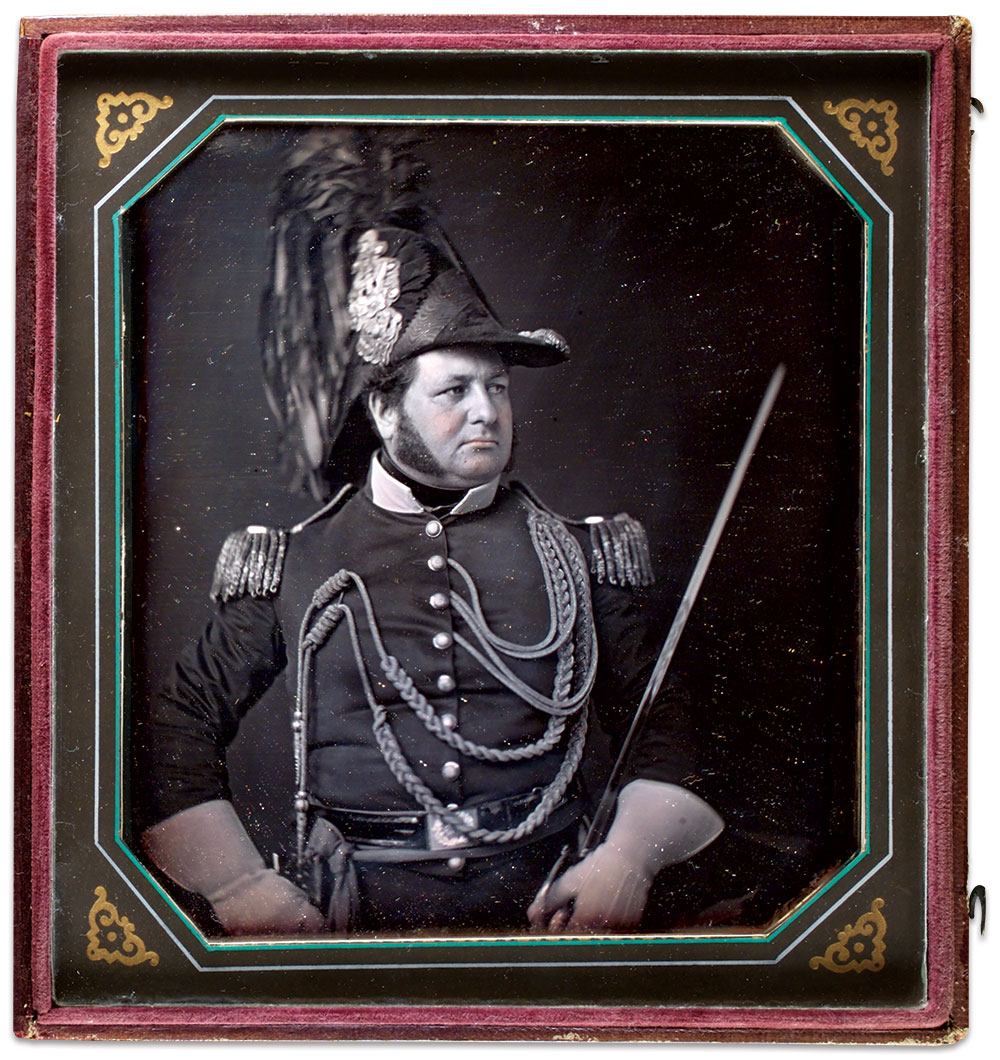By George S. Whiteley IV
I’ve had a keen interest in military images from the very beginning of my antique photograph collecting pursuit nearly half a century ago. Sometimes a historical reunion magically happens between multiple images taken of the same person who initially sat for them. Over the course of many years they can become separated, often scattered to faraway locations, occasionally to opposite ends of the country. It rarely happens, but miraculously, they can come back together again. This happened in late 2022 for me, being able to reunite two Marcus Aurelius Root masterpieces of daguerreian artistry, one of which I previously never knew existed.
More than 25 years ago I took a chance, and bought the most expensive photograph I had purchased up to that time. It was a three-quarter plate daguerreotype of a regally posed Philadelphia militia officer taken by one of the most talented daguerreian artists of the era. Even though it appeared in an eBay auction two-and-a-half decades ago, I vividly remember the occasion, anxiously awaiting the final day of the sale, and nervously counting down the final seconds of the auction on my watch. This was the way to bid, before the advent of any snipe programs so commonly used today. I wasn’t even at home when the auction ended, staying with friends in Asheville, N.C., and using their computer, which added even more anxiety. I pressed the submit button and, with just a few seconds left, elatedly won the auction. Back home, and upon receiving it in the mail, it was an even better image in person than was portrayed online. I am still delighted to have it as a part of my collection all these years.

Time marches on. When the Daguerreian Society met in Philadelphia in 2009, our host there was the Library Company of Philadelphia. During the opening evening’s reception at the Library Company, a special exhibit of selected cased images were displayed from their collections. Lo-and-behold, there was another three-quarter plate daguerreotype of this same militia officer on view, taken by Root’s Gallery. The two images were obviously produced the same day, except theirs was a different pose with the subject standing wearing his impressive dress chapeau-de-bras, rather than it being proudly displayed atop an American flag-draped table as seen in my daguerreotype. I compared notes with the curator, and she was pleased to learn that another daguerreotype of this man had come to light.
My sense of history kicked in, and wanting to keep the two pieces together, a deal was struck early the following morning at the show.
This past fall, I got wind of yet another daguerreotype of this same militia officer. A small mid-western auction company offered it, except this one was a full-plate size. I called the auction company and had a lengthy chat with the people there about the listed image. The photographs they posted online were of poor quality, and their description of a “picture on glass,” made no mention that it was a daguerreotype. I politely asked them to take some additional photos, and probed for specific details of the image. The new photos were only marginally better, and I called back to ask a few more questions and leave a bid. As I really wanted to reunite the two daguerreotypes, I left a hefty bid thinking surely no one else would go that high. This must have surprised the person I was speaking with and, while he went to record my bid, he laid the phone down inadvertently leaving it open so I could hear the ensuing conversation between him and his co-workers. He stated that he had someone on the phone from Georgia who was willing to spend a fair amount of money on this item and asked, “Just what do we have here?” to his fellow worker. I sincerely believe they had no idea that their “picture on glass” was a daguerreotype, or who the Root Gallery was, stamped on the case pad. I was not at home the day of the auction, and upon returning the auction had already closed. When I looked up the auction results online, I was crushed to find out that I was not the winner, but the underbidder. Apparently someone else also knew what it was and bid accordingly. It was quite a disappointment, but you can only do what you can do, and I resigned myself to continue enjoying the image I already owned.

As the daguerreotype collector world is relatively small, I thought the one that got away just might surface again sometime in the future. Little did I know that would happen just a few weeks later at the 2022 Daguerreian Society symposium in Chicago. This was the first live symposium since the advent of Covid-19 shut everything down in early 2020. My wife and I looked forward to seeing old friends, and enjoying the camaraderie of our fellow photo enthusiasts in the Daguerreian Society. While room hopping the night before the trade-fair—there it was—in Michael Peterson’s room, the full-plate daguerreotype of the militiaman I so admired! Michael had recently purchased it from a California dealer—the high bidder in the auction in which I was the underbidder. The daguerreotype was definitely better in-person than the auction company photos had portrayed, and I agonized overnight about its purchase. It was even more costly than the mate to it I bought so many years prior, and a substantial bump over my top bid with the auction company. My sense of history kicked in, and wanting to keep the two pieces together, a deal was struck early the following morning at the show. The image finally came my way after it had traversed the continent, and come halfway back.
The two images are now, once again, side-by-side some 175 years after being taken just minutes apart on the same day back in the 1840s.

It is hard to tell which one of my two daguerreotypes was taken first, but I feel that of the three known images of this man taken in Root’s gallery, the initial one I purchased was taken second to the full plate. Some details addressed in the full-plate were visually changed in the one I own, making a slightly cleaner presence. They are very similar in pose and appearance, but with a lot of little differences. There’s no explanation as to why the different size plates were taken. But they all were taken from the same basic viewpoint, most likely with the same camera, with just different size plate holders. Perhaps, the sitter wanted to don his showy headgear in the image owned by the Library Company, rather than to have it simply serve as a fanciful accessory as in his other daguerreotypes. Since it is the same size as the initial one I bought, it would make sense that the Library Company image would be taken last, as the first two were already posed and so similar. The other three-quarter daguerreotype plate may have already been prepared and the camera was ready for that format, rather than a full-plate size.
The mystery continues, as this noble-appearing man has yet to be identified, other than being an officer in a Pennsylvania militia unit, and having the foresight to have his likeness recorded by a master at 140 Chestnut Street in Philadelphia. Fortunately his countenances have been reunited and preserved for further study. Here they all are, together again after one-and three-quarter centuries.
George S. Whiteley IV began his life-long collecting odyssey with the advent of the Civil War Centennial in 1961 assembling a very nice collection of Civil War artifacts over the course of several years. Curiously, his collection did not include photographs. Years later, with that collection long gone, and working at the Georgia Department of Archives & History as a photographer for the Vanishing Georgia project, and later their photographs archivist, an interest in early photography emerged and he became fascinated with daguerreotypes and Civil War photographs. In his professional career, George curated exhibits for the Georgia Archives, Atlanta History Center and High Museum of Art, and has been a willing lender to numerous other institutions and museums. A serious interest in historical photography has remained constant for nearly 50 years, along with dual passions for classic BMWs, hiking and photography.
SPREAD THE WORD: We encourage you to share this story on social media and elsewhere to educate and raise awareness. If you wish to use any image on this page for another purpose, please request permission.
LEARN MORE about Military Images, America’s only magazine dedicated to showcasing, interpreting and preserving Civil War portrait photography.
VISIT OUR STORE to subscribe, renew a subscription, and more.


1 thought on “Reunion Magic Brings Together Daguerreotypes of a Philadelphia Militia Officer: Portraits taken minutes apart 175 years ago are reunited”
Comments are closed.